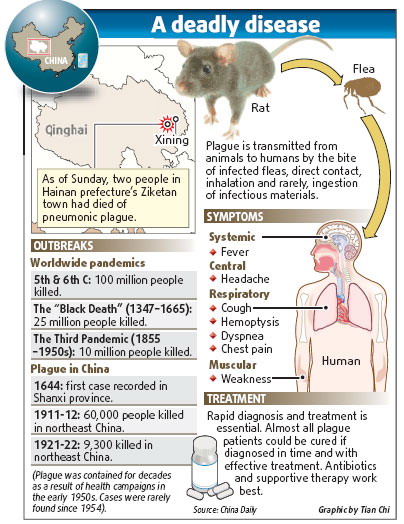
|
CHINA> Regional
 |
|
Outbreak seals town of 10,000
By Hu Yinan (China Daily)
Updated: 2009-08-04 07:18 A town of 10,000 people in the northwestern province of Qinghai has been sealed off after three men died of pneumonic plague and nine others were affected, health authorities said. The latest victim was a man named Danzhi, 64, from the town of Ziketan, in Xinghai county in the Hainan Tibetan Autonomous Prefecture, who died yesterday. A 37-year-old man named Danzin, reportedly died Sunday morning in Ziketan. "People are so scared," said a food seller surnamed Han at the Crystal Alley Market. "There are few people on the streets," Han said by telephone.
He was a neighbor of the disease's first fatality, identified by official sources only as a 32-year-old herdsman. Of the nine patients in quarantined, one is in a serious condition and another has developed symptoms of coughing and chest pain. They are mainly relatives of the deceased and have been isolated in hospital, where they are receiving treatment. There has been no report of new infections. The 3,000-sq-km town is in lockdown, with local people unable to travel outside its boundaries. The residents are being monitored by disease control experts. The WHO's spokeswoman in China, Vivian Tan, said yesterday that the government reported the first death and 11 other cases to the organization on Saturday. "This is not new," Tan said. "There have been sporadic cases reported over the years. We're not surprised that it's come up. We're in constant contact with the authorities to make sure things are under control. "In cases like this, we encourage the authorities to identify cases, to investigate any suspicious symptoms among close contacts and to treat confirmed cases as soon as possible. So far, they have done exactly that, so at this point we don't have any additional advice," Tan said. An official at the Qinghai government's health department said authorities were confident about keeping the outbreak under control. "There's little possibility of it spreading," said the official, who only provided his family name, Li. "We have already closed off the infected area. We are currently treating those who are sick." Han, the food seller, said authorities have called for homes and shops to be disinfected and said residents should wear masks when they go out. He said 80 percent of the shops were closed and prices of disinfectants and some vegetables had tripled. "There are police guarding the quarantine center at the township hospital but not on the streets," Han said. An official surnamed Wang at the disease control center said the measures taken were "scientific, orderly, effective and in accordance with the law." A woman who lives in Ziketan and who refused to give her name said officials distributed fliers and made TV and radio announcements on how to prevent infection.
 The woman, contacted by phone, said police checkpoints were set up in a 28 km radius around Ziketan and residents were not allowed to leave. Qinghai, a relatively remote province where proximity to animals such as rats and fleas is common, has reported two minor pneumonic plague outbreaks in the past eight years, the China National Radio Network said. The first outbreak, in May 2001, involved a 29-year-old rural Tibetan, who was bitten by fleas as he skinned a fox. In 2004, eight villagers in Qinghai died of plague, most of them infected after killing or eating wild marmots. Marmots are related to gophers and prairie dogs. They live in the grasslands of China's northwest and Mongolia, where villagers often hunt them for meat. This time, the herdsman in Ziketan reportedly died four days after he buried his dog. The pneumonic plague is the most virulent form of plague. For those who are untreated, the death rate is 60 percent and many die within 24 hours. But early diagnosis and treatment with antibiotics, including streptomycin and tetracycline, cut the mortality rate to less than 15 percent, according to the WHO. Officials from Qinghai's health bureau have advised anyone with a fever or cough since July 16 to seek hospital treatment. The pneumonic plague was responsible for many deaths in northeast China in two separate outbreaks, in 1911 and 1921. The first killed 60,000 people, while the second claimed 9,300 lives, according to Ma Xuebo, a medical history scholar at the Harbin Medical University. AP and Xinhua contributed to the story |